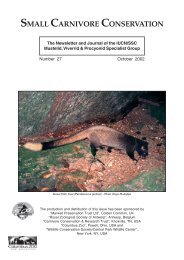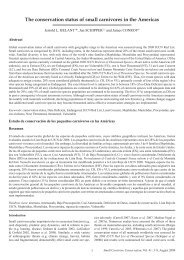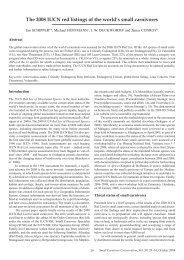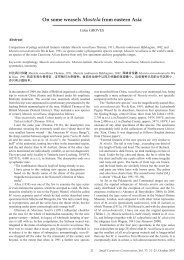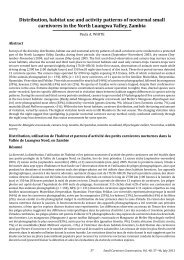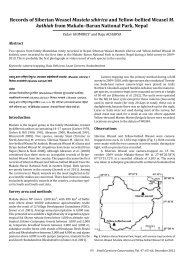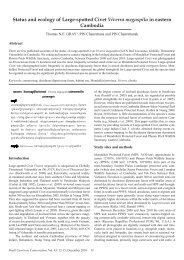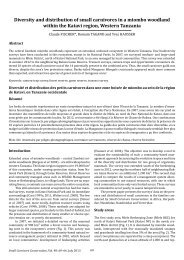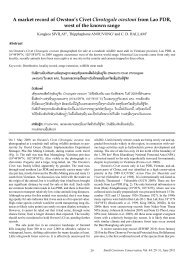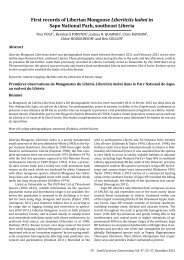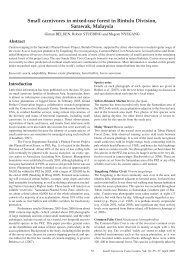An early claim of Red Panda Ailurus fulgens from Vietnam - Small ...
An early claim of Red Panda Ailurus fulgens from Vietnam - Small ...
An early claim of Red Panda Ailurus fulgens from Vietnam - Small ...
- No tags were found...
Create successful ePaper yourself
Turn your PDF publications into a flip-book with our unique Google optimized e-Paper software.
<strong>An</strong> <strong>early</strong> <strong>claim</strong> <strong>of</strong> <strong>Red</strong> <strong>Panda</strong> <strong>Ailurus</strong> <strong>fulgens</strong> <strong>from</strong> <strong>Vietnam</strong><br />
G. B. SCHROERING<br />
Abstract<br />
There remains no pro<strong>of</strong> that <strong>Red</strong> <strong>Panda</strong> <strong>Ailurus</strong> <strong>fulgens</strong> inhabited Lao PDR or <strong>Vietnam</strong> in historical times, but in 1904, a generally<br />
reputable account <strong>of</strong> the mammals <strong>of</strong> Indochina (accompanying results <strong>of</strong> the Pavie expedition) stated, without caveat, that it occurred<br />
in Tonkin, the northernmost part <strong>of</strong> <strong>Vietnam</strong>. No basis is given for this statement so its accuracy is unclear; but it expands suggestions<br />
<strong>of</strong> <strong>Red</strong> <strong>Panda</strong> occurrence <strong>from</strong> solely within hunters’ memoirs into the scientific literature.<br />
Keywords: geographic range, historical opinion, Pavie expedition, Tonkin<br />
In a recent review <strong>of</strong> reports <strong>of</strong> <strong>Red</strong> <strong>Panda</strong> <strong>Ailurus</strong> <strong>fulgens</strong> <strong>from</strong><br />
south and southeast <strong>of</strong> its known geographic range, Duckworth<br />
(2011) discussed extensively the history <strong>of</strong> such reports <strong>from</strong> <strong>Vietnam</strong><br />
and nearby countries. The earliest source traced for <strong>Red</strong><br />
<strong>Panda</strong> in Indochina was Roussel (1913), but the compilation overlooked<br />
de Pousargues (1904). Moreover, other <strong>early</strong> sources <strong>from</strong><br />
this region (excepting simple tabulated lists <strong>of</strong> species believed to inhabit<br />
Indochina) are all hunters’ memoirs; de Pousargues’s (1904)<br />
text discuses the results <strong>of</strong> the Pavie scientific exploration during<br />
1879–1895 and provides a comprehensive overview <strong>of</strong> the mammals<br />
<strong>of</strong> Indochina.<br />
De Pousargues (1904: 521) wrote that “cette petite espèce<br />
méridionale est représentée vers le Nord, dans le Tonkin [the northernmost<br />
part <strong>of</strong> modern-day <strong>Vietnam</strong>], par une autre plus robuste,<br />
l’Ours du Tibet, Ursus tibetanus [sic] (G. Cuv.), qu’accompagnent<br />
quelques individus du genre unispécifique, <strong>Ailurus</strong> <strong>fulgens</strong><br />
(F. Cuv.), ou <strong>Panda</strong> éclatant” (this small southern [in Indochina]<br />
species [Sun Bear Ursus malayanus] is replaced to the north, in<br />
Tonkin, by Asian Black Bear U. thibetanus and by several individuals<br />
<strong>of</strong> a monospecific genus, the <strong>Red</strong> <strong>Panda</strong>). Nothing in de<br />
Pousargues (1904) illuminates the meaning behind ‘several individuals’.<br />
That it is not simply a text compilation error is indicated<br />
by the Table <strong>of</strong> mammals <strong>of</strong> Indochina on p. 545, which indicates<br />
again (by use <strong>of</strong> a ‘ditto’ mark) that <strong>Red</strong> <strong>Panda</strong> inhabits Tonkin.<br />
De Pousargues (1904) did not detail his basis for believing<br />
that <strong>Red</strong> <strong>Panda</strong> occurred in Tonkin (the northernmost part <strong>of</strong> <strong>Vietnam</strong>).<br />
It seems unlikely that the expedition had acquired any specimens<br />
<strong>of</strong> it, because the collection was exhibited in the Muséum<br />
National d’Histoire Naturelle, Paris (MNHN) shortly after its return<br />
to France in 1895, yet Delacour (1940), who used the MNHN<br />
collections extensively in his account <strong>of</strong> the mammals <strong>of</strong> Indochina,<br />
did not countenance the occurrence <strong>of</strong> <strong>Red</strong> <strong>Panda</strong> there.<br />
However, the ship carrying the Pavie collection was wrecked <strong>of</strong>f<br />
the Somali coast and although much <strong>of</strong> the collection survived,<br />
some cases <strong>of</strong> material were lost (de Pousargues 1904), so it is<br />
possible that <strong>Red</strong> <strong>Panda</strong> specimen(s) had been collected. All the<br />
other carnivores stated by de Pousargues (1904, table and text) to<br />
occur in Indochina without caveat are now known to do so, independently<br />
<strong>from</strong> de Pousargues, in the regions mentioned for them:<br />
this statement <strong>of</strong> <strong>Red</strong> <strong>Panda</strong> occurrence gains credibility because<br />
it is not accompanied by multiple obviously implausible <strong>claim</strong>s.<br />
(The listing for Thailand <strong>of</strong> the mongoose Herpestes griseus is<br />
here unidentifiable as this name was applied historically to all <strong>of</strong><br />
H. ichneumon, H. auropunctatus and H. edwardsii [Van Rompaey<br />
& Colyn 1996], and the possibility <strong>of</strong> occurrence <strong>of</strong> H. auropunctatus<br />
in Thailand [also listed by Pavie directly] remains unclear<br />
[Veron et al. 2006]; and the listing <strong>of</strong> the Sundaic Felis diardi is a<br />
simple nomenclatural error for the northern Southeast Asian Felis<br />
[now = Ne<strong>of</strong>elis] nebulosa.)<br />
De Pousargues’s (1904) laconic treatment <strong>of</strong> <strong>Red</strong> <strong>Panda</strong>,<br />
with no comment that occurrence in Tonkin was surprising in the<br />
context <strong>of</strong> contemporary perceptions <strong>of</strong> <strong>Red</strong> <strong>Panda</strong> distribution,<br />
suggests the possibility that yet earlier statements <strong>of</strong> the species in<br />
<strong>Vietnam</strong> may exist. Alternatively, it may simply reflect de Pousargues’s<br />
(1896: 180) earlier expressed opinion that “d’un autre côté,<br />
toute la partie Sud du Yun-nan ne diffère pas géographiquement<br />
de la Birmanie, du Haut Tonkin et du Sud-Est de la Chine,<br />
et nous retrouvons dans les types mammalogïques rapportés de<br />
cette region par le prince Henri d’Orléans la plupart des espèces<br />
signalées déjà par <strong>An</strong>derson sur les frontières du Yun-nan et de<br />
la Birmanie, et par Swinhoe dans les provinces sud-orientales de<br />
l’empire chinois” (in contrast [to the similarities between northwest<br />
Yunnan and Szechwan], all southern Yunnan resembles, geographically,<br />
Burma, upper Tonkin and southeast China, and most<br />
<strong>of</strong> the mammal forms reported <strong>from</strong> southern Yunnan by Prince<br />
Henry d’Orléans [the collection under discussion] have already<br />
been found by <strong>An</strong>derson along the Yunnan–Burma frontier or<br />
by Swinhoe in southeast China): de Pousargues’s (1896) noted<br />
(fide <strong>An</strong>derson) that <strong>Red</strong> <strong>Panda</strong> was particularly common on the<br />
Yunnan–Myanmar frontier, and so would not have been particularly<br />
surprised to find it in Tonkin.<br />
It remains difficult to see how such a distinctive animal could<br />
have inhabited the area into the late 19th century and presumably<br />
into the first half <strong>of</strong> the 20th century, the main era <strong>of</strong> specimencollecting<br />
expeditions, and not have been found. Two <strong>Red</strong> <strong>Panda</strong><br />
specimens purchased in Hanoi in 1931 were taken at the time to be<br />
<strong>from</strong> international trade (Duckworth 2011), raising the possibility<br />
that de Pousargues’s (1904) view was also based, unbeknownst to<br />
him, on trade animals <strong>from</strong> Hanoi or elsewhere in Tonkin. A fair<br />
amount <strong>of</strong> <strong>Vietnam</strong>’s northern highlands lie at altitudes suitable<br />
for <strong>Red</strong> <strong>Panda</strong>, but habitat would be atypical (it is not annually<br />
snowbound, for example), so it is conceivable that <strong>Red</strong> <strong>Panda</strong> did<br />
inhabit <strong>Vietnam</strong> but was eradicated before being collected or otherwise<br />
securely documented there.<br />
In conclusion, the mention <strong>of</strong> <strong>Red</strong> <strong>Panda</strong> in de Pousargues<br />
(1904) makes it less surprising that hunters were discussing the<br />
species in the memoirs <strong>of</strong> Indochina, secure in the knowledge <strong>from</strong><br />
its listing in this generally authoritative source that it did indeed<br />
live there.<br />
Acknowledgements<br />
I thank the two referees for their comments.<br />
<strong>Small</strong> Carnivore Conservation, Vol. 44: 40–41, June 2011<br />
40
Early <strong>Red</strong> <strong>Panda</strong> <strong>claim</strong> <strong>from</strong> <strong>Vietnam</strong><br />
References<br />
Delacour, J. 1940. Liste provisoire des mammifères de l’Indochine<br />
française. Mammalia 4: 20–29, 46–58.<br />
Duckworth, J. W. 2011. Records and reports <strong>of</strong> <strong>Red</strong> <strong>Panda</strong>s <strong>Ailurus</strong> <strong>fulgens</strong><br />
<strong>from</strong> areas with warm climates. Pp. 419–434 in Glatston, A. R.<br />
(ed.) <strong>Red</strong> <strong>Panda</strong>: biology and conservation <strong>of</strong> the first panda. Academic<br />
Press, London, U.K.<br />
de Pousargues, E. 1896. Sur la collection de mammifères rapportés du Yunnan<br />
par le Prince Henri d’Orléans. Bulletin du Muséum d’Histoire<br />
Naturelle 2: 179–182.<br />
de Pousargues, E. 1904. Mammifères de l’Indo-Chine. Pp. 510–549 in<br />
Pavie, A. (ed.) Recherches sur l’histoire naturelle de l’Indochine ori-<br />
entale. Mission Pavie en Indochine 1879–1895. Études diverses. III.<br />
Recherches sur l’histoire naturelle. Ernest Leroux, Paris, France.<br />
Roussel, L. 1913. La chasse en Indochine. Plon-Nourrit et Cie, Paris, France.<br />
Van Rompaey, H. & Colyn, M. 1996. <strong>An</strong> annotated bibliography <strong>of</strong> the<br />
Herpestidae and Viverridae (Carnvora, Mammalia). <strong>An</strong>nales du Musée<br />
Royal de 1’Afrique Centrale, Sciences Zoologiques 279: 1–411.<br />
Veron, G., Patou, M.-L., Pothet, G., Simberl<strong>of</strong>f, D. & Jennings, A. P. 2006.<br />
Systematic status and biogeography <strong>of</strong> the Javan and <strong>Small</strong> Indian<br />
Mongooses (Herpestidae, Carnivora). Zoologica Scripta 36: 1–10.<br />
125/5 Ruam Rudee, Ploenchit Rd., Bangkok 10330, Thailand.<br />
Email: gbs119@gmail.com<br />
41 <strong>Small</strong> Carnivore Conservation, Vol. 44, June 2011



